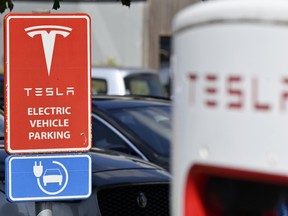Perversely, Ottawa’s 100% tariffs on EVs ensures the price of hybrids remains more attractive
Article content
When politicians make important financial decisions based on a movie they may have seen as kids, it shouldn’t come as a shock if the results prove to be sub-optimal.
Field of Dreams was a hit 1989 film based on a 1982 novel about a 1919 baseball scandal. An Iowa farmer played by Kevin Costner repeatedly hears an ethereal voice advising him “If you build it, he will come.” So he constructs a ball diamond in a corn field and, sure enough, long-dead figures from a long-gone baseball team — including Ray Liotta as his dad — come wandering out of the fields for a game of pick-up.
Advertisement 2
Article content
As far as I can tell, the justification for handing tens of billions of dollars to corporate auto behemoths to help them build battery plants for electric vehicles (EVs) has its roots in the same principle: no matter how uncertain the EV vehicle outlook may be, governments in Ottawa, Ontario and Quebec insist success is inevitable. If we build the plants, buyers will come.
It hasn’t been working out that way. The initial dream of stylish, emissionless vehicles gliding silently through the countryside has run into growing public awareness there are potholes involved. Batteries are very heavy, and anything but cheap. There’s the whole issue of range uncertainty, the relative paucity of charging stations and the unreliability of those that exist, not to mention the fact vast sections of the planet lack the will, the capacity, the money or the intention of building the massive infrastructure required for the EV revolution. Sure 93 per cent of new cars sold in Norway, population 5.6 million, are electric; in India, population 1.5 billion, it’s two per cent. Norway boasts a US$1.7 trillion oil-fuelled wealth fund. India has an average annual income of US$1,314.
Advertisement 3
Article content
The result is that EV sales are lagging, and the auto firms are rethinking strategies. Volkswagen was planning six new battery plants, but now says the schedule may be delayed. “There is for the time being no business rationale for deciding on further sites,” CEO Oliver Blume told Czech officials keen on being among the choices. A decision, said Blume, will be “based on market conditions, including the sluggish ramp up of the (EV) market in Europe.”
Ford Motors is likewise curbing its enthusiasm for the all-EV future, putting off a $1.8 billion plan to transform its Oakville, Ont. facility into a “state of the art” hub for EV production, to be renamed the Oakville Electric Vehicle Complex. Instead it will retool the plant to pump out the F-Series Super Duty pickup, a traditional gas-guzzling emissions machine.
Government thinking behind EV policies was straight from Field of Dreams, with a twist: automakers would be strongarmed into building them while drivers would be bribed into buying them. Regulations unveiled by Canada’s Liberals in 2023 were typical of the genre: sales of new gas-fuelled vehicles would effectively be blocked by 2035, while auto firms would be required to demonstrate a regular increase in the availability of EVs, whether demand justified it or not.
Advertisement 4
Article content
Hard as they might try, there is only so much politicians can do to force their views on a skeptical population, and the EV crusade is a case in point. While sales of fully electric vehicles are lagging, hybrid vehicles are selling quickly. Former Toyota chief executive Akio Toyoda predicted as much when he argued that the rush to toss aside a century of engine technology in favour of a still-developing replacement was getting ahead of itself, as much of the world just wasn’t ready. Toyota produced the first-ever mass-market hybrid car more than 25 years ago, yet Toyoda’s view was considered so out of line he felt the need to step aside in 2023 in favour of a less skeptical, more with-it successor.
Turns out he was right, though. While EV sales tail off, hybrid demand is brisk. With both a gas engine and small electric motor, hybrids don’t carry the same concerns about range or recharging stations. They cost less, improve mileage and reduce emissions. U.S. hybrid sales increased 53 per cent in the U.S. in 2023 over the previous year, and another 50 per cent in the first months of this year. The Wall Street Journal reported that hybrids have been selling almost three times faster than EVs and twice as fast as traditional internal combustion versions. In making its Oakville announcement, Ford held out hope the revamp “paves the way to bring multi-energy technology to the next generation of Super Duty trucks.” But they were talking hybrids, not electric.
Advertisement 5
Article content
Don’t expect that to make an impression on the politicians. Governments in Ontario, Ottawa and Quebec have dedicated so many billions, and so much verbiage, to their battery blueprints they’re not about to change their tune just because the market does. Fields big enough to hold numerous ballparks are already being cleared for the battery plants, walls are going up, hiring is underway.
At least equally important is the amount of political capital at stake, with none of the three men behind the big subsidy cheques — Prime Minister Justin Trudeau and Premiers Doug Ford and François Legault — popular enough that they can afford to lose much more of it. Ford and Trudeau recently visited an Ontario Goodyear plant to herald an expansion supported by $64 million in subsidies. EVs are good for the tire sales, as their added weight wears out tires faster than usual. The plant will produce specially-designed EV tires, no doubt with specially-designed prices to match.
Until EV prices come down and something is done about the range and recharging situation, buyers are likely to continue choosing hybrids over full electrics. Perversely, western governments are doing their best to keep it that way. Trudeau announced on Monday that Canada will join the U.S. in imposing 100 per cent tariffs on imports of cheaper Chinese vehicles, ensuring buyers will be blocked from competitive pricing and ensuring the gap between EVs and hybrids will remain.
One way or another, Canada is going to have a battery industry. The coffers are open to government handouts. If only they could talk Kevin Costner into helping gin up some sales.
National Post
Recommended from Editorial
Our website is the place for the latest breaking news, exclusive scoops, longreads and provocative commentary. Please bookmark nationalpost.com and sign up for our daily newsletter, Posted, here.
Article content








